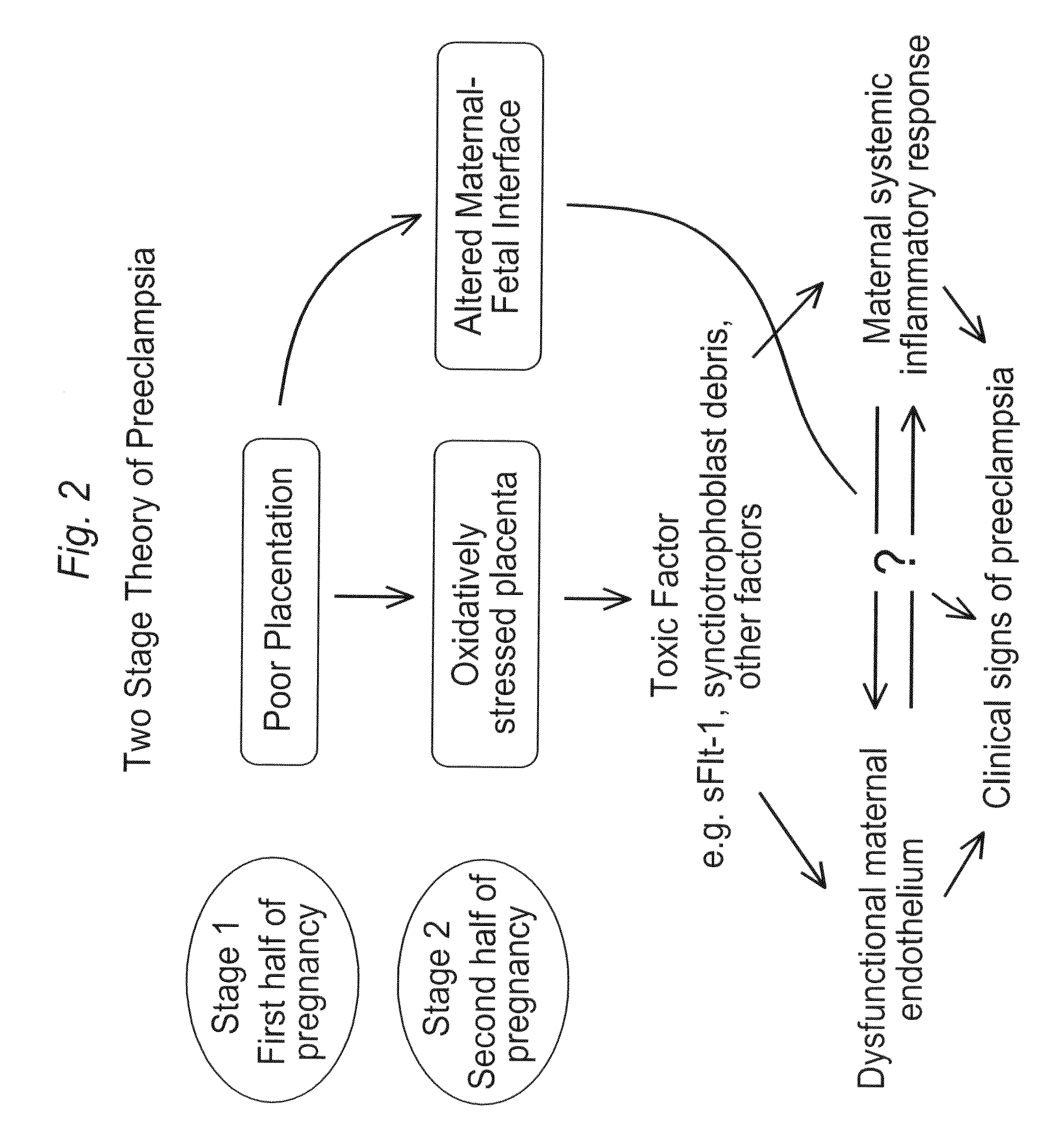Biomarkers for preeclampsia
a preeclampsia and biomarker technology, applied in the field of preeclampsia biomarkers, can solve the problems of preeclampsia, placental abruption, maternal death, and related deaths, and achieve the effect of avoiding maternal immune rejection
- Summary
- Abstract
- Description
- Claims
- Application Information
AI Technical Summary
Benefits of technology
Problems solved by technology
Method used
Image
Examples
example 1
Materials and Methods
[0099]The University of California San Francisco Committee on Human Research approved the tissue procurement protocol. Informed consent was obtained from each parturient before delivery. Basal plate biopsy specimens of the maternal-fetal interface from preeclampsia patients and patients with preterm labor (control) were collected. The basal plate was dissected from the placenta proper, rinsed in PBS and diced into ˜3×3 mm3 pieces, which were snap-frozen in liquid nitrogen and stored at −70° C. All samples were processed and frozen within 1 h of delivery. For immunohistochemistry, biopsy samples of the basal plate were fixed in 3% paraformaldehyde in PBS (wt / vol), passed through a sucrose gradient (5-15% in PBS) and frozen in OCT (optimal cutting temperature).
[0100]In addition, biopsies of several regions of the tissue were also fixed in ten-percent neutral-buffered formalin and embedded in paraffin. Tissue sections prepared from the blocks were ...
example 2
Differentially Expressed Genes in the Maternal-Fetal Interface in Preeclampsia Study Design
[0109]Using the general methods described above, we undertook to identify genes that were differentially expressed at the maternal-fetal interface (basal plate) in subjects with preeclampsia versus subjects experiencing preterm labor as controls. The characteristics of the study design are shown below in Table 1. A total of 23 samples were analyzed. 11 of these were preterm labor (PTL) controls and 12 were samples from preeclampsia pateients with the clinical presentations shown in Table 1, including an elevated blood pressure of ±140 / 90 and proteinuria greater than 300 mg / 24 hours or a protein dipstick reading of ≧1+.
TABLE 1Study DesignProspectively collect human basal platePreterm pregnancies (24-36 wk)SingletonPreeclampsia:Elevated BP ± 140 / 90Proteinuria > 300 mg / 24 h or ≧1+ clean catchNo PPROM, infection or maternal disease (except HTN)Controls:Preterm laborno PPROM, infection or maternal ...
example 3
Prediction of Risk for Developing Preeclampsia
[0115]The identification of the molecular markers of the present invention allow a physician to determine a patient's risk for the development of preeclampsia. Because multiple and distinct genes are upregulated or down regulated in preeclampsia, the particular expression pattern of one or more, or all, of these genes can serve as a molecular signature with which to predict the risk of development of preeclampsia in an otherwise asymptomatic patient. Accordingly, a placental biopsy or a sample of bodily fluid (e.g., blood, saliva, cervicovaginal fluid, or urine) is taken from a patient. The gene expression pattern of the sample for the markers of this invention (mRNA or the corresponding polypeptides) is determined. Based on the particular markers expressed, as well as their levels, a patient's risk for the development of preeclampsia is assessed.
PUM
| Property | Measurement | Unit |
|---|---|---|
| blood pressure | aaaaa | aaaaa |
| blood pressure | aaaaa | aaaaa |
| Tm | aaaaa | aaaaa |
Abstract
Description
Claims
Application Information
 Login to View More
Login to View More - R&D
- Intellectual Property
- Life Sciences
- Materials
- Tech Scout
- Unparalleled Data Quality
- Higher Quality Content
- 60% Fewer Hallucinations
Browse by: Latest US Patents, China's latest patents, Technical Efficacy Thesaurus, Application Domain, Technology Topic, Popular Technical Reports.
© 2025 PatSnap. All rights reserved.Legal|Privacy policy|Modern Slavery Act Transparency Statement|Sitemap|About US| Contact US: help@patsnap.com



